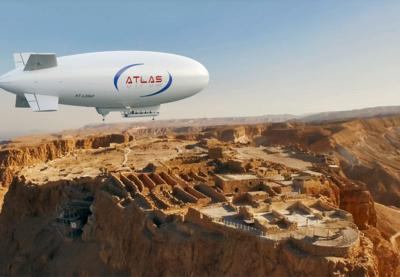Thu, Sep 10, 2020
This Location Allows Relatively Easy Transportation Of Materials And Components
Newly-established Israeli company, Atlas LTA Advanced Technology Ltd, has brought together leading experts from around the world in the unique field of lighter-than-air technology. The core team members have extensive experience in building airships and aerostats for all kinds of purpose, and together offer a solid technical background for the company’s current production activities and future developments.

Atlas's main goal is to introduce its green airships into everyday life, thereby reducing poisonous carbon emissions. The company is active in many fields, delivering practical, cost-effective solutions in the form of modern airships and aerostats. For example, Atlas-6/11 sightseeing airships are sparking curiosity at national parks and historic landmarks all over the world.
The advantages of the lighter-than-air technologies proposed by Atlas can also be clearly seen in the context of communications and surveillance missions. High altitude, long range, and unprecedented endurance of unmanned flight all contribute to making tethered aerostats or solar-powered airships a unique and highly-effective solution in several instances where traditional aircraft cannot be used. Besides the obvious economic advantages, their performance does not require the burning of any traditional fuel.
Atlas's flagship project is to build a new family of large-capacity transport airships, which will be capable of carrying oversized and overweight cargo of up to 165 tons, using safe helium buoyancy and dynamic lift made possible by low-emission hybrid-electric propulsion. Named ATLANT, this airship will significantly reduce transportation costs and will eventually change the world of cargo transportation. Since it does not require any special infrastructure, it can land in a desert, on water or even Arctic ice, making many hard-to-reach destinations much more accessible.
Based on the company’s latest innovations and practical achievements, this ambitious project applies important lessons learnt from its predecessors. Use of hydrogen as its fuel will make ATLANT the first zero-emission, large-capacity cargo aircraft. In the future, when the rules permit, it can be turned into a fully-autonomous unmanned cargo vehicle – the world’s largest UAV. The ATLANT is expected to be emission free within the next six to seven years.
More News
He Attempted To Restart The Engine Three Times. On The Third Restart Attempt, He Noticed That Flames Were Coming Out From The Right Wing Near The Fuel Cap Analysis: The pilot repor>[...]
Make Sure You NEVER Miss A New Story From Aero-News Network Do you ever feel like you never see posts from a certain person or page on Facebook or Instagram? Here’s how you c>[...]
From 2009 (YouTube Edition): Leading Air Show Performers Give Their Best Advice for Newcomers On December 6th through December 9th, the Paris Las Vegas Hotel hosted over 1,500 air >[...]
Aero Linx: NASA ASRS ASRS captures confidential reports, analyzes the resulting aviation safety data, and disseminates vital information to the aviation community. The ASRS is an i>[...]
“For our inaugural Pylon Racing Seminar in Roswell, we were thrilled to certify 60 pilots across our six closed-course pylon race classes. Not only did this year’s PRS >[...]
 NTSB Final Report: Rutan Long-EZ
NTSB Final Report: Rutan Long-EZ ANN FAQ: Turn On Post Notifications
ANN FAQ: Turn On Post Notifications Classic Aero-TV: ICAS Perspectives - Advice for New Air Show Performers
Classic Aero-TV: ICAS Perspectives - Advice for New Air Show Performers ANN's Daily Aero-Linx (06.28.25)
ANN's Daily Aero-Linx (06.28.25) Aero-News: Quote of the Day (06.28.25)
Aero-News: Quote of the Day (06.28.25)



